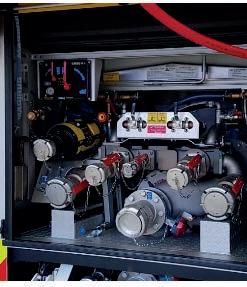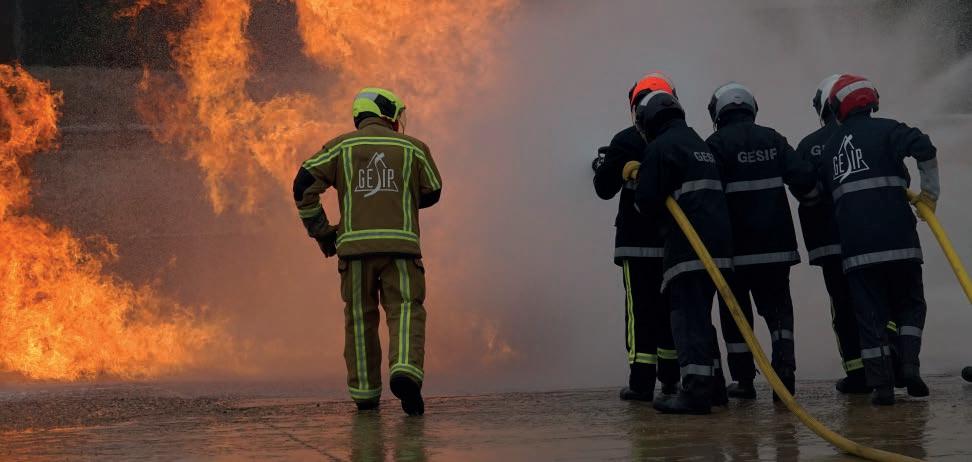
9 minute read
High Risk Industries In Europe & Foam Manufacturers Facing Fast Moving Discussions Over PFAS Regulation in Firefighting Foam
by Catalyst
JUST TRYING
HIGH RISK INDUSTRIES IN EUROPE AS WELL FOAM MANUFACTURERS AT THE MOMENT ARE FACING A FAST MOVING DISCUSSION OVER PFAS REGULATION IN FIRE FIGHTING FOAMS.
Advertisement
Already regulated substances like PFOS and PFOA are pushing the disussion of foam concepts toward the F3* foams. Overall question is: Can F3 foams substitute the performance of AFFF? What we have already learned from tests in the past is that a one to one replacement of AFFF or AFFF-AR is nearly impossible. Especially concepts which are working with aqueous film formation, like the Footprint™ principle for tank fire fighting (with nearly nonaspirated foam) on non-polar solvents need to be renewed. Using F3 foams for larger class B fuel fires means that foam formation is the key to success. In mobile applications the test of foam expansion ratio is quite easy. Nearly all aspirated foam nozzles and low expansion foam tubes create a good and well performing foam to achive good extinguishing results. [picture bottom right – foam test] But tests on non-aspirated nozzles show that the foam expansion ratio is in relation to the nozzle design, foaming properties of the F3 foam and the pressure at the nozzle. So, a generalisation for the application is not possible and a specific test needs to be carried out. A good foam expansion (ratio) helps the F3 foams to perform as designed. This principle is also confirmed by the EN 1568 part 3 fire test. A foam expansion ratio at the test nozzle near 1:10 is quite good. But how to reduce F3 foams’ fuel pick up? AFFF‘s have a minimal fuel pick up behavior created by the fluorosurfactant. F3 foams do not have any fluorinated raw materials in their composition. Additionally the bubble structure and the application have a huge influence on the fuel pick up capability. Meaning, a more homogenous bubble structure and a less forceful application helps not to load too much fuel into the foam blanket. Of these benefits we have heard for
years now from the compressed air foam system (CAFS) manufacturers. Second benefit of CAFS is the extended throwing length of aerated foam. Conventional foam reduces the throwing length up to 30% easily. AFFF foam water solution has nearly the same throwing length as water and was preferred for long distance operations e.g. at loading racks or processing plants. For these reasons it is good to give this technology in combination with F3 foams some more attention. At a client’s site we
had the possiblity to attend a training of the plant fire brigade. The test pit has dimensions of 10 m by 20 m (200 sqm) and is filled with approx. 6000 litres of unleaded gasoline. The preburn time was approx. 60 sec. As you see the documentation is not as detailed, because it was more of a training exercise to collect some experience. The challenge was to extinguish the fire with only one CAFS nozzle at a flow of 400 l/min. foam. Therefore we needed to check the numbers. Regularly we recommend an application rate of 6 - 8 l/min./sqm. For 200 sqm we talk about a realistic application of approx. 1200 l/min. for a safe and fast flame control for in depth fires (more than 25mm fuel depth). The named 400 l/min is compressed air foam, means we are talking about a foam expansion ratio of 1:8. So we are facing a real application of 50 l/min. Compared to EN 1568-3 approval test with an application rate of 2,5 l/min/ sqm we should need an application of 500 l/min [ten times more] foam water solution. Some may ask why so much less application: the explanation is superficial – that was the maximum flow of the

CAFS test unit which was available.

rate. Very impressive was that these smaller quantities were finally able to handle the incident. We are convinced that the 90% control time with the minimum application rate of 2,5 l/min./ m² would be acceptable and with the recommended 6 - 8 l/min./m² very fast. The questions which arise now are: by what factor does CAFS improve the extinguishment time results? To answer this we know we need more tests. We need to compare the CAFS technology with F3 foams to conventional foam application (like low expansion foam) with F3 foams. Then we need to change the application rate and later on test on different fuels. Looks like we are at the beginning of a new and huge project with evironmental friendly and high performing foams. But who is willing to do these tests and likes to share a lesson learned?
Just give it a try!
Author: Martin Gorski, 42 Fire fighter since 1996
Key account manager and foamconcept consultant at Dr. Sthamer Hamburg, Germany
But only 1/10th of the minimum application rate brings up some interesting results. In the first long seconds nothing happened at all and a subjective perspective came up, that the relation between the amount of foam applied and the size of the fire was disproportionate. But after 58 seconds we saw the first formation of a

foam blanket (foam foot print) at the end of the foam stream. After an additional 100 seconds the fire fighters started to extend the foam blanket by sweeping gently to the left and to the right. After approx. 50% flame control the operator of the CAF unit switched from wet CAF to dry CAF. With that change the throwing length shortens dramatically but the direct and forceful application turned into a more gentle but still direct application. The burnback resistance of the dry foam helped a lot to strengthen the foam blanket at the edge. After 5:42 min. the fire was out.
Reignition of the fuel: On the side of foam application any reignition was not successful. On the opposite side the fuel was still visible and detected „by nose“. We know this effect from other tests, where the fuel is pushed to one side of the pit. Because of additional pollution of the air the fire chiefs decided not to
restart the fire.
What we have learned: The CAFS Technology built up an homogenous and stable foam with our 0.5% vaPUREx® LV (F3) foam. Especially in dry CAF operation the burnback resistance helped a lot to control the flames and extend and secure the build up of the foam blanket. The very limited amount of water extended the extinguishing time. For better planning and related data it makes sense to handle small and big tests with an equal application

NEW LEADER MIX 2000 FOAM PROPORTIONING SYSTEM
The fire equipment manufacturer LEADER just launched a new version of autonomous proportioning system: LEADER MIX 2000. With its patented mechanical and automatic mixing system, the new LEADER MIX 2000 fits for different firefighting scenarios, ensure reliable and optimum operation with low operational cost. A new version which completes the range of autonomous proportioner until then limited to 1000 l/ min. Let’s discover more!

EASY TO USE AND VERSATILE FOAM DOSING SYSTEM
Designed and patented by the R&D team of the LEADER company, its unique system based on a venturi system achieve an automatic accurate aspiration of foam concentrate required to mix with water. Several fixed mixing ratios from 0.1% to 6% are available. Simple and easy to use, the firefighter just has to turn a manual selector to immediately set up and adjust the mixing ratio. Ideal equipment for various fire interventions, the LEADER MIX 2000 is suitable for a wide flow range from 300 to 2000 l/min. It realises real-time adjustment, without human intervention, of current water flow and in case of flow variations. On large scale fire requiring high flow, it is possible to combine several LEADER MIX 2000 to go up to even larger flows. By coupling two LEADER MIX 2000, you achieve flow ranges of 600 to 4000l/min. The LEADER MIX 2000 handle all foam concentrate types, including AR-types (wetting-foaming agents, fluorine-free foam concentrate, AFFF, AFFF-AR, proteinic foam, etc.), whether their viscosity: liquids foams (Newtonian fluids) or highly viscous foams (pseudoplastic). The equipment has been tested and calibrated for an accurate dosing, particularly for highly viscous pseudoplastic foam concentrates proportioned at 1% and 3%. The quality and performance of the produced foam are greatly related to the equipment used. With the LEADER MIX 2000, get an accurate foam and water mix for successful firefighting and avoiding to waste water and precious stock of foam concentrate. The control panel allows to select the intervention position: water, foam or flush. The “water” position (by-pass) reduces pressure loss in the water supply when foam injection is not necessary. The “flush” position allows the dosing system to be rinsed and clean up for the next operation. The simple interface is easily understandable for fast and flawless action.
RELIABLE FOAM PROPORTIONER FOR LONGLASTING OPERATION
As key part of the foam fire extinguishing system, the LEADER MIX 2000 foam proportioner is a 100% mechanical system, reliable and autonomous. It stand-alone and is ready to produce foam immediately. It operates without electronics and without external power supply, unlike electronic foam proportioning technologies. No periodic maintenance is required. The absence of a metering pump increases the reliability of the system and allows dry operation if the end of the tank is reached. This equipment has very low operational cost. All parts and components are corrosion resistant.
MAXIMUM FLEXIBILITY
This foam proportioning system is suitable for municipal fire departments, as well as for petrochemicals plants, industrial plants, logistics warehouses, waste treatment plants applications. Matching project specific requirements, the LEADER MIX 2000 mixing system can be easily installed in a centralized foam extinguishing system (foam pourer, deluge system, high expansion foam generator…) or on a fire fighting vehicle in its “fixed” version. In its “portable” version, it can be placed on the ground close to the foam concentrate storage or on remote locations. Its “plug & play” robust construction as well as its extremely compact and light format (less than 35kg) give him maximum flexibility.
To learn more about the LEADER MIX 2000, visit www.leader-group.company.

A major company for several decades, LEADER designs, manufactures and promotes high performing equipment used in firefighting and search and rescue applications. LEADER offers innovative products such as PPV fans for firefighting, Search equipment for tech rescue operations, flame simulators for training, etc.










